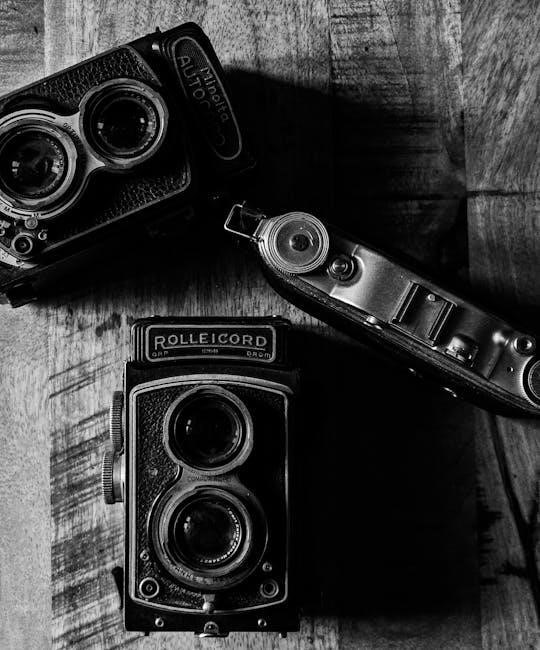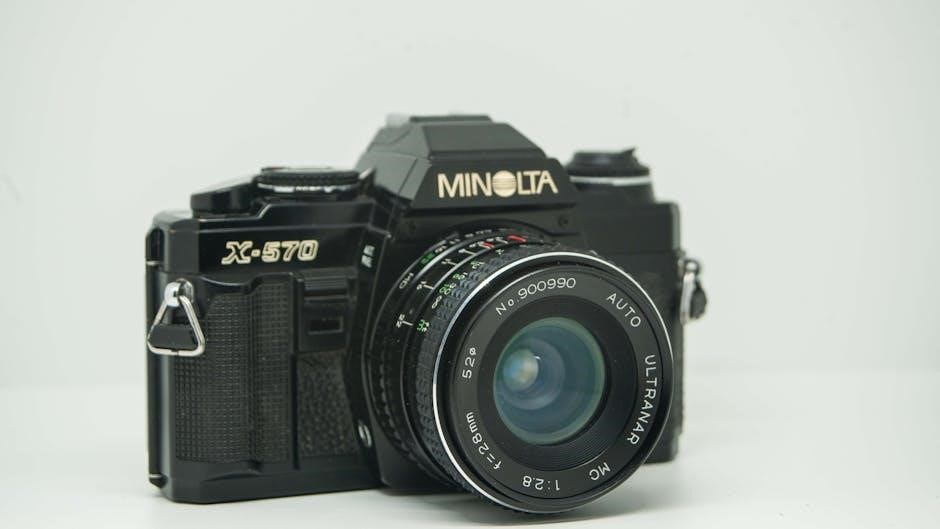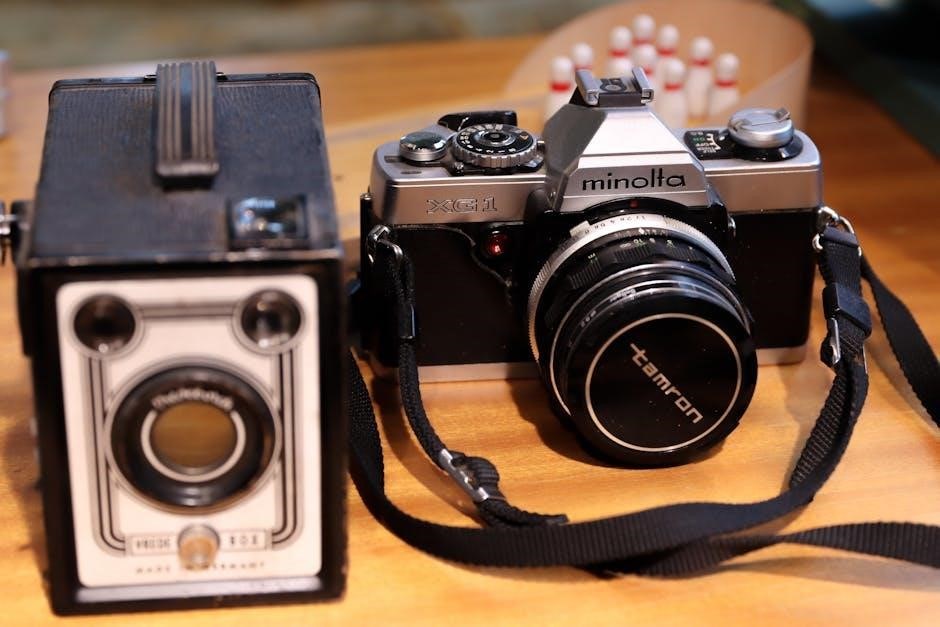The Minolta XG-1 is a compact 35mm film SLR camera‚ offering aperture priority and manual modes. Designed for enthusiasts and professionals‚ it features an advanced electronic shutter system and compatibility with MD Rokkor lenses.
1.1 Brief History of the Minolta XG-1
The Minolta XG-1 was introduced in the late 1970s as part of Minolta’s XG series‚ designed to offer a more compact and user-friendly alternative to earlier SLR models. It quickly gained popularity among amateur and professional photographers for its blend of simplicity and advanced features. The camera was known for its electronic shutter system and compatibility with Minolta’s MD Rokkor lenses‚ making it a versatile tool for various photographic needs. Its release marked a significant step in Minolta’s evolution in the film camera market.
1.2 Key Features and Target Audience
The Minolta XG-1 is a lightweight and ergonomic SLR camera‚ featuring aperture priority and manual modes. It is equipped with an electronic shutter system‚ offering stepless speeds from 1/1000 to 1 second. The camera is compatible with Minolta’s MD Rokkor lenses‚ providing versatility for various photography needs. Targeted at both photography enthusiasts and professionals‚ the XG-1 combines simplicity with advanced features‚ making it ideal for those seeking precise control over their shots. Its compact design and intuitive controls further enhance its appeal.

Key Features of the Minolta XG-1
The Minolta XG-1 features an electronic shutter system‚ aperture priority‚ and manual modes. It is compact‚ lightweight‚ and compatible with MD Rokkor lenses for versatile photography.
2.1 Aperture Priority and Manual Modes
The Minolta XG-1 offers both aperture priority and full manual modes‚ providing photographers with flexibility. In aperture priority mode‚ users set the aperture‚ and the camera automatically adjusts the shutter speed for optimal exposure. In manual mode‚ photographers control both aperture and shutter speed‚ allowing for precise creative control. These modes cater to both casual shooters and professionals‚ ensuring versatility in various lighting conditions. The electronic shutter system supports stepless speeds from 1/1000 to 1 second‚ enhancing exposure accuracy.
2.2 Metering System and Exposure Control
The Minolta XG-1 features a center-weighted metering system‚ providing accurate exposure readings by prioritizing the central area of the frame. This system is effective in various lighting conditions‚ ensuring balanced exposures. The camera offers exposure compensation options‚ allowing users to adjust settings based on creative preferences. With its reliable metering and intuitive controls‚ the XG-1 delivers consistent results‚ making it a versatile tool for photographers seeking precision and ease of use. Its exposure control capabilities cater to both amateur and professional needs.

Camera Controls and Layout
The Minolta XG-1 features intuitive external controls‚ including aperture and shutter speed dials‚ ensuring easy access and logical placement for seamless operation. ISO settings and film speed adjustments are straightforward‚ enhancing user experience.
3.1 External Controls and Buttons
The Minolta XG-1 features a well-designed layout with intuitive external controls. The aperture ring and shutter speed dial are easily accessible‚ allowing for quick adjustments. The ISO dial‚ located on the base‚ simplifies film speed settings. A convenient meter switch enables light metering‚ while the lens release button allows for seamless lens changes. These ergonomic controls enhance user experience‚ making the camera easy to operate for both professionals and enthusiasts.
3.2 ISO Settings and Film Speed
The Minolta XG-1 allows for flexible ISO settings‚ ranging from 25 to 1600‚ to accommodate various lighting conditions. This feature ensures optimal image quality by enabling photographers to adjust film sensitivity based on the environment; The ISO dial‚ conveniently located on the camera’s base‚ simplifies the process of selecting the appropriate film speed. This versatility makes the XG-1 suitable for both indoor and outdoor photography‚ catering to the needs of enthusiasts and professionals alike.

Shooting Modes and Settings
The Minolta XG-1 offers automatic aperture priority and full manual modes‚ providing photographers with precise control over exposure. Multiple exposure capability enhances creative shooting options.
4.1 Automatic Mode
In Automatic Mode‚ the Minolta XG-1 offers aperture priority‚ allowing the camera to control shutter speed for optimal exposure. This mode is ideal for casual shooters‚ as it simplifies the process while delivering precise results. The electronic system automatically adjusts settings‚ ensuring well-balanced images in various lighting conditions. Photographers can focus on composition without worrying about manual adjustments. The XG-1’s automatic capabilities make it accessible to enthusiasts while still offering enough flexibility for creative control. This mode is perfect for capturing spontaneous moments with ease and reliability.
4.2 Manual Mode
The Manual Mode on the Minolta XG-1 offers full control over aperture and shutter speed‚ allowing photographers to fine-tune their settings for precise results. With stepless shutter speeds ranging from 1/1000 to 1 second‚ plus extended manual settings‚ users can achieve creative control in various lighting conditions. The electromagnetic shutter release ensures smooth operation‚ while compatibility with MD and MC Rokkor lenses enhances flexibility. This mode is ideal for experienced photographers seeking advanced control over their shots‚ providing the freedom to experiment and optimize exposures manually.
Lens Compatibility
The Minolta XG-1 is compatible with MD and MC Rokkor lenses‚ ensuring high optical quality and versatility for various photography needs.
5.1 MD and MC Rokkor Lenses
The Minolta XG-1 seamlessly integrates with MD and MC Rokkor lenses‚ renowned for their exceptional optical quality and durability. These lenses offer a wide range of focal lengths‚ from wide-angle to telephoto‚ catering to diverse photographic applications. The MD series features advanced multi-coating technology to minimize flare and enhance contrast‚ while the MC series provides manual focusing precision. Both series are backward compatible‚ ensuring versatility for photographers who value high-quality optics and creative flexibility.
5.2 Third-Party Lens Compatibility
The Minolta XG-1 supports third-party lenses with the use of adapters‚ expanding its versatility. While native MD and MC Rokkor lenses are optimized for the system‚ photographers can experiment with lenses from brands like Nikon and Canon when adapted. However‚ full functionality may vary‚ and some features like aperture control might require manual adjustment. This compatibility opens creative possibilities for enthusiasts and professionals seeking to utilize their existing lens collections with the XG-1.

Accessories for the Minolta XG-1
The Minolta XG-1 offers a variety of accessories‚ including interchangeable viewfinders‚ screens‚ and flashes. These enhance functionality and compatibility with additional photography gear for diverse shooting needs.
6.1 Viewfinders and Screens
The Minolta XG-1 offers interchangeable viewfinders and screens‚ enhancing customization for photographers. The standard viewfinder provides a clear‚ bright view‚ while optional models include features like split-image focusing and microprism rangefinders. Interchangeable screens allow users to adapt to specific shooting needs‚ such as high-contrast or precision focusing. These accessories cater to both casual and professional photographers‚ ensuring optimal control over framing and focus. The system’s flexibility makes it versatile for various photographic applications and styles.
6.2 Flash and Studio Lighting
The Minolta XG-1 supports a wide range of flash and studio lighting options for enhanced illumination. It features a hot shoe mount for dedicated flash units‚ ensuring precise synchronization. Additionally‚ it is compatible with Minolta’s Auto Electroflash series‚ offering automatic flash exposure control. For studio settings‚ the XG-1 can be paired with external strobes via a PC sync socket‚ providing professional-level lighting control. These capabilities make the camera versatile for both on-location and studio photography‚ catering to photographers seeking advanced lighting solutions.

Maintenance and Cleaning
Regular maintenance ensures optimal performance of the Minolta XG-1. Clean the lens and mirror with a soft cloth and avoid harsh chemicals. Lubricate moving parts as needed and check battery connections for corrosion. Proper care extends the camera’s lifespan and maintains its functionality.
7.1 Cleaning the Lens and Mirror
Proper cleaning of the lens and mirror is essential for maintaining image quality. Use a soft‚ dry microfiber cloth to gently wipe the lens‚ avoiding harsh chemicals. For the mirror‚ remove the lens and use a brush or compressed air to remove dust. Never touch the mirror surface directly‚ as oils from skin can damage it. Regular cleaning prevents smudges and debris from affecting your photos. Always store the camera in a protective case to minimize dust exposure. Cleaning should be done in a clean‚ dry environment to ensure optimal results.
7.2 Lubrication and Battery Care
Regular lubrication of moving parts ensures smooth operation‚ but avoid over-lubrication to prevent damage. Use a high-quality‚ lightweight grease on gears and hinges. Replace batteries every 6-12 months or when the light meter dims. Use LR44 or SR44 batteries for optimal performance. Store batteries in a cool‚ dry place away from metal objects. Clean battery contacts with a soft cloth to maintain good connections. Proper care extends the camera’s lifespan and ensures reliable functionality. Always refer to the service manual for specific lubrication intervals and battery recommendations.
Troubleshooting Common Issues
The Minolta XG-1 may face issues like shutter malfunctions or light meter inaccuracies. Regular cleaning and proper battery maintenance often resolve these problems; Consult the service manual for detailed solutions.
8.1 Shutter Malfunction
Shutter malfunctions in the Minolta XG-1 can manifest as slow or stuck shutter curtains‚ often due to mechanical wear or dirt. Symptoms include inconsistent exposure or complete shutter failure. To address this‚ clean the shutter mechanism gently with a soft brush and ensure proper battery power‚ as low voltage can impair performance. If issues persist‚ consult the service manual for advanced troubleshooting or seek professional repair to restore optimal functionality and maintain image quality. Regular maintenance is crucial to prevent such malfunctions.
8.2 Light Metering Problems
Light metering issues in the Minolta XG-1 can lead to inaccurate exposures‚ often caused by faulty sensors or misaligned metering components. Symptoms include overexposed or underexposed images. To resolve this‚ ensure the camera’s battery is fully charged‚ as low power can affect metering accuracy. Clean the light meter sensor gently with a soft cloth and verify that the ISO setting matches the film speed. If problems persist‚ consult the service manual for diagnostic steps or seek professional assistance to restore precise metering functionality and achieve consistent results. Regular calibration is recommended to maintain performance.
The Minolta XG-1 remains a versatile and compact film SLR‚ offering excellent performance for both enthusiasts and professionals. Its enduring appeal lies in its intuitive design and reliability.
9.1 Final Thoughts on the Minolta XG-1
The Minolta XG-1 is a standout choice for photographers seeking a blend of simplicity and advanced features. Its compact design‚ intuitive controls‚ and robust performance make it ideal for both beginners and seasoned professionals. The camera’s ability to switch between automatic and manual modes ensures versatility‚ while its compatibility with a wide range of MD and MC Rokkor lenses enhances creative possibilities. With proper care‚ the XG-1 remains a reliable and enduring tool for capturing high-quality images‚ solidifying its place as a beloved classic in film photography.
